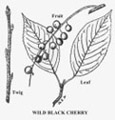| Bark - at
first smooth, reddish brown in color, marked with easily seen, long, white breathing
pores; with age becoming much roughened by irregular, close, dark scaly circular plates
with upturned edges. Twigs
- slender, smooth, reddish brown in color, having bitter almond taste which is
characteristic of all cherries.
Winter buds - smooth,
ovate, 1/8 to 1/6 inch long, sharp-pointed, chestnut brown in color; terminal bud present.
Leaves - alternate,
simple, 2 to 5 inches long, lanceolate, broader than are those of pin cherry, fairly
long-pointed, margin finely serrate, tufts of hair along midrib on undersurface of leaf.
Fruit - a
single-seeded juicy fruit, about 1/2 inch in diameter, grouped on very short stems, in
long scattered, drooping clusters, purplish black when ripe in late summer. Birds and
animals eat the fruit, though its flavor is decidedly bitter.
Distinguishing features
- long white pores on young bark; dark scaly, circular, saucer-like plates in older
bark; hairy midrib below on leaf; fruit in short-stemmed clusters.
13a. Sweet cherry or bird cherry (Prunus
avium Linnaeus) is an escaped cultivated cherry found in abandoned fields and
hedgerows. Its shiny red bark and thick twigs are its outstanding features.
[introduction] [the keys] [list of 50 trees] [making a tree
collection]
[back to the homepage]
|
